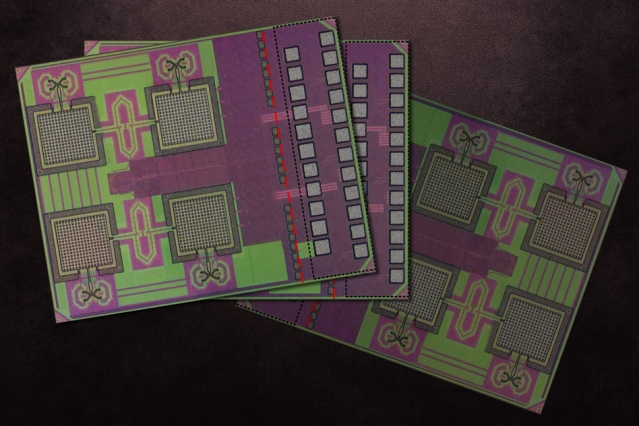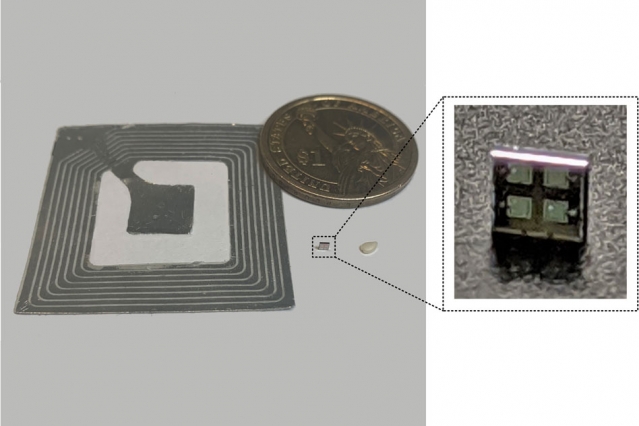By Gina Roos, editor-in-chief
Researchers at the Massachusetts Institute of Technology (MIT) have invented a tiny cryptographic ID tag that can fit on almost any product to verify authenticity. This includes integration into larger silicon chips. The millimeter-sized ID chip integrates a cryptographic processor, an antenna array, and photodiodes for power.
Counterfeiting is a huge problem. The Organization for Economic Co-operation and Development estimates that about $2 trillion worth of counterfeit goods will be sold worldwide in 2020, according to a 2018 report, and the Semiconductor Industry Association has pegged annual losses to the U.S. semiconductor industry at about $7.5 billion.
“The U.S. semiconductor industry suffered $7 billion to $10 billion in losses annually because of counterfeit chips,” said Muhammad Ibrahim Wasiq Khan, MIT graduate and team researcher, in a statement. “Our chip can be seamlessly integrated into other electronic chips for security purposes, so it could have huge impact on industry. Our chips cost a few cents each, but the technology is priceless.”
Researchers said that the new ID tag solves many of the challenges that come with today’s wireless ID tags used for authentication, including size, cost, power consumption, and security tradeoffs. Examples cited include radio-frequency identification (RFID) tags that are too large to fit on small products — such as medical and industrial components, automotive parts, or silicon chips — with limited security measures. Even if the tags provide encryption schemes, they’re large and also power-hungry, said MIT.

The millimeter-sized ID chip integrates a cryptographic processor, an antenna array, and photovoltaic diodes for power. (Image courtesy of MIT researchers, edited by MIT News)
MIT researchers describe their ID chip as a “tag of everything,” solving many of the challenges seen in today’s wireless ID and RFID tags. In a paper released at a recent IEEE International Solid-State Circuits Conference (ISSCC), the researchers said that the ID chip operates on low levels of power supplied by photovoltaic diodes.
Another interesting feature is that the ID chip transmits data at far ranges thanks to a power-free “backscatter” technique that operates at a frequency “hundreds of times higher than RFIDs.” In addition, the chip uses algorithm optimization techniques to run a popular cryptography scheme that delivers secure communications using extremely low energy, said researchers.
“If I want to track the logistics of, say, a single bolt or tooth implant or silicon chip, current RFID tags don’t enable that,” said co-author Ruonan Han, an associate professor in the Department of Electrical Engineering and Computer Science and head of the Terahertz Integrated Electronics Group in the Microsystems Technology Laboratories (MTL), in a statement. “We built a low-cost, tiny chip — without packaging, batteries, or other external components — that stores and transmits sensitive data.”
Co-authors include graduate students Mohamed I. Ibrahim and Muhammad Ibrahim Wasiq Khan; former graduate student Chiraag S. Juvekar; former postdoc associate Wanyeong Jung; former postdoc Rabia Tugce Yazicigil, who is currently an assistant professor at Boston University and a visiting scholar at MIT; and Anantha P. Chandrakasan, who is the dean of the MIT School of Engineering and the Vannevar Bush Professor of Electrical Engineering and Computer Science.
The team wanted to create a better RFID tag by eliminating the packaging, which adds size and cost; using high terahertz frequency, about 100 GHz and 10 THz, to enable integration of the antenna array and wireless communications at greater reader distances; and adding cryptographic protocols.
Ibrahim said that they developed a “a pretty big system integration” that enabled the researchers to pack everything on a monolithic silicon chip, measuring 1.6 mm2 .

The ID tag (right) sends wireless communications at reader distances competitive with the larger RFID tags (left) and can run cryptographic algorithms to help secure nearly any product in the supply chain. (Image courtesy of MIT researchers )
Researchers said that the ID chip integrates an array of small antennas that transmit data back and forth via backscattering between the tag and reader in which the antennas use signal splitting and mixing techniques to backscatter signals in the terahertz range. “Those signals first connect with the reader and then send data for encryption,” they said.
The antenna array also uses a beam-steering function that increases signal strength and range and reduces interference. This is the first demonstration of beam steering in a backscattering tag, said researchers.
The ID chip uses photodiodes to power the chip’s processor, which runs the chip’s “elliptic curve cryptography” (ECC) scheme that combines private and public keys to keep communications private.
“Optimizing the cryptographic code and hardware lets the scheme run on an energy-efficient and small processor,” said Yazicigil, an assistant professor at Boston University and a visiting scholar at MIT, in a statement.
“It’s always a tradeoff,” she said. “If you tolerate a higher-power budget and larger size, you can include cryptography. But the challenge is having security in such a small tag with a low power budget.”
Next steps for the researchers are extending the current signal range of about 5 cm and powering the chip through the terahertz signals to eliminate the photodiodes.
Advertisement
Learn more about Electronic Products Magazine





